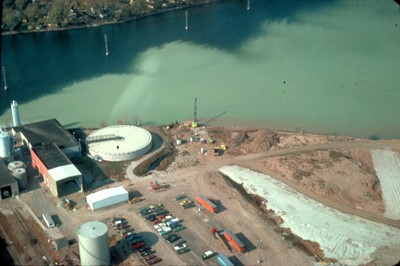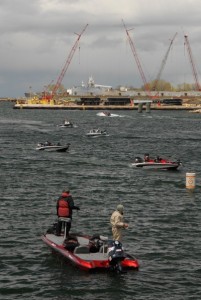How Environmental Regulation Helped Save Door County’s Fisheries
- Share
- Tweet
- Pin
- Share

An estimated 65 million pounds of fish are harvested from the Great Lakes every year, with commercial and sport fishing contributing an estimated $4 – 7 billion annually to the economy.
In Door and Kewaunee counties alone, sport fishing supports at least 27 charter fishing operations. These are charters and individual sportsmen who bring their own boats to the peninsula spend money on campsites, hotel rooms and second homes. They buy boats, bait and gear at stores from Algoma to Washington Island. They fill gas tanks, pay launch fees, rent slips and when the day is done, they celebrate with brews and food at local bars and restaurants.
Their activities are immensely valuable to the local economy, and they wouldn’t exist today if not for environmental regulation.
Though in most news accounts the word is almost said with disdain and followed by a lawmaker, lobbyist or corporate face calling it a job-killer, an economic calamity, or an affront to freedom, we can thank regulation for millions of dollars in economic impact every year.

Dumping untreated waste sludge directly into rivers and streams was a common practice along the Fox River into the 1970s.
In the 1960s, the paper industry had a pretty sweet deal for itself. The stretch along the Fox River from Lake Winnebago to Green Bay was home to the largest concentration of paper manufacturers in the world, in part because it was home to the cheapest waste disposal system an industry could ask for – the Fox River. These paper mills simply pumped their waste and byproducts into the river, and they weren’t alone. Manufacturers and businesses of all kinds along the river did the same. All told, 300,000 pounds of effluent was discharged into the river every day between Lake Winnebago and Green Bay.
Individual citizens weren’t any kinder to the waterway. People threw their trash in the river, old motor oil, car batteries, even cars. But much to the chagrin of industry and individuals, scientists began connecting the dots between this garbage and toxic chemicals.
In 1970 the DNR began testing fish for PCBs, and those pulled from Lake Michigan and its tributaries showed alarming concentrations of polychlorinated biphenyls, or PCBs. These synthetic organic compounds were found to cause cancer in animals, cause skin conditions and immune system disorders in humans, and are linked to non-Hodgkin lymphoma. The PCBs were traced primarily to the production of carbon copy paper and wastewater sludge that was discharged into the river, and eventually, into Green Bay.
At least 250,000 pounds of PCBs were released into the river, and at least 160,000 pounds entered Green Bay.
Lake trout, chubs and coho salmon testing revealed concentrations of 10.2 ppm of PCBs in between 1972 and 1974. At various points in the 1970s and 1980s whitefish tested as high as 17 ppm, at a time when the level believed acceptable for humans to eat was just 5 ppm (reduced to 2 ppm in 1984).
This was not good news for the fishing and tourism industries. Commercial fishing had already absorbed a beating in the middle part of the century, as the whitefish population was devastated by overfishing and the arrival of invasive species that outcompeted it for food, namely the alewife. In 1879 11 million kg of whitefish were harvested on the lakes. In 1959, just 701,000 kg were caught, and many predicted extinction was around the corner. Sport fishing, meanwhile, was devastated by the sea lamprey, which eviscerated the lakes greatest natural predator, the lake trout.
But in the mid-1960s the Department of Natural Resources, then called the conservation department, wrote one of the biggest fish tales in history. Howard Tanner of the Michigan DNR decided to plant coho salmon in the lake in hopes of creating a world-class sport fishery.
(Many believe salmon were introduced to control the alewife population, which at that time accounted for at least 85 percent of the fish biomass in the lake and had so overrun the ecosystem that they were dying off by the thousands, washing up in stinking masses on beaches throughout the lake. But Tanner was adamant in a 2011 interview that alewife control was only a secondary goal.
“You don’t stock cows to keep the grass short, you stock cows to eat beef,” Tanner said.)
It worked phenomenally. Within three years the salmon were reproducing on their own, and word spread rapidly of the remarkable new fishery. The Lake Michigan shoreline was inundated with fishermen hauling boats from Illinois, Western Wisconsin, and Minnesota to catch their fill.
But news that Lake Michigan’s fish carried high concentrations of PCBs scared the public.
In 1976 the Wisconsin Department of Natural Resources issued its first consumption advisories for fish pulled from the river and Green Bay, advising consumers not to eat more than one meal per week of carp, trout and salmon more than 20 inches caught in Green Bay and Lake Michigan.
Lee Kernen has been studying, monitoring and fishing on the lake for 50 years. He worked as an aquatics biologist with the conservation department in 1968, when he was tapped to head up the salmon stocking program in Green Bay, Door and Kewaunee counties.
“No sooner had we created this incredible fishery, then this scare looked like it was going to wipe it out,” he said. “In Minnesota the garbage men complained that the trash stank so bad because fishermen were throwing out the prize fish they had brought home from Lake Michigan.”
Kernen said many believed it was unethical to continue stocking big sport fish.
“Had we not implemented the clean air and water acts, we would have an absolute catastrophe. Regulation is the only way we can protect the environment and human health.” – David O. Carpenter, Director of the School for Public Health, University of Albany.
“By stocking the salmon, we were encouraging people to catch and eat fish that could give them cancer,” he said.
The future of the river looked so bleak in fact, that radical ideas were suggested.
“One alderman even suggested filling in the river for a parking lot,” Kernen said, “leaving just a small stretch for water to flow.”
Charlie Henriksen has been a commercial fisherman on the lake for 40 years. He said the mid-1970s were a time when fishermen were caught in a tug of war between industry and environmentalists, with the thread of their livelihood fraying in the middle.
“We wanted the lake cleaned up, no question, but we felt that the fishermen were being used as a pry bar to force the paper mills to change,” he said. “By being alarmist about the dangers of eating the fish, they could flip public sentiment against the paper mills and industry to promote clean water. But the paper mills were threatening to move, and we didn’t want to be used against all the jobs down there.”
Henriksen said the risks of fish consumption are overblown.
“PCBs were a big deal, but I always thought it was overblown as a health risk in terms of humans eating fish,” Henriksen said. “The allowable PCB level in fish was always less than it was in other animals. No question there is concern. We thought the long-term effects probably weren’t as bad as they were made out to be.”

Door Peninsula waters are considered a world-class sport fishery, attracting millions in revenue from fishermen like these at the Sturgeon Bay Open Bass Tournament.
Longtime angler and outdoors writer Kevin Naze agreed.
“I still don’t think they have a single example of a documented case where someone was shown to get cancer from eating fish,” Naze said. “Even at the peak of concern, your risk of getting cancer was said to be increased by 1 in 10,000 if you ate a lot of fish, but that didn’t account for whether you were smart about preparing it, cutting off the skin and fatty parts that hold most of the contaminants.”
David O. Carpenter, Director of the School of Public Health at the University of Albany in New York, studies fish contamination in the Great Lakes and worldwide and sees both sides of the debate.
“We have a lot of contaminant information, but we don’t have as much info on the benefits of Omega-3 acids, for example,” he said. Fish consumption, he said, shouldn’t be studied in a vacuum where only the risks are evaluated. “It may be that the benefits outweigh the risks. Unfortunately, we lack a simple way to advise the public. Fish don’t come with a label of DDT or PCB levels, and contamination is very localized, so it’s not as simple as saying that salmon have this and perch have that. I’m very frustrated with where we are.”
For example, three meals of fish and vegetables in a week may in fact be better for long-term health than three meals of pizza, or burgers and fries. But whatever the contaminant level is, Carpenter said “these chemicals are simply not going to be good for anyone, and they put the immune system at risk for a host of things.”
Carpenter, it should be noted, rarely eats fish, and never from a farm. He prefers to eat food he has raised on his own farm, including beef, because he knows exactly where it comes from.
The Comeback
But the activism of the late 1960s and early 1970s paid off.
The Clean Water Act of 1972 banned most of the point-source pollution that devastated the Fox River and other Lake Michigan tributaries. New standards were set for the quality of water that could be discharged into waterways after industrial use, and in 1979, PCB production was banned as well.
During the past 44 years further legislation and clean-up has led to a remarkable recovery of the river and bay. Along the lower Fox River, 262 chemical spills have been cleaned up and 582 leaking underground storage tank cases removed or fixed.

Many fishermen believe the state’s fish eating guidelines are overly cautious. Graphic from the Wisconsin Department of Natural Resources.
By the mid-1980s, contaminant levels in Great Lakes fish were dropping every year. Today, the average Lake Michigan whitefish carries a PCB concentration of less than 1 ppm.
Since 1993, studies of Great Lakes Charter boat captains and anglers – the heaviest eaters of Great Lakes fish, have shown decreased exposure to PCBs and DDE (a metabolite of DDT).
DNR fish biologist Scott Hansen said the slow recovery of Green Bay has played a big role in improving the fishery.
“As rivers have been cleaned, the fish are more able to spawn and grow,” he said. “The clean up of the Fox, Peshtigo, Oconto rivers has made a tremendous impact in that regard especially in the comeback of the whitefish. In 2013, DNR documented spawning condition whitefish in those rivers, where previously we only saw that in the Menominee.”
Even the Fox River is now producing good runs of whitefish, Hansen said. “That’s just unbelievable in my mind for a place like the Fox River that has been so bad,” he said.
Though the picture is much better for the fishery today, the impact of the unregulated era of the 1950s and 1960s remains.
“A lot of people are still scared to eat fish from the lake,” Naze said. “The reputation is still tainted, but this is a world-class fishery.”
The lakes are not an ode to the natural order. Lake Michigan is overrun by invasive species. More than 950 trillion quagga mussels blanket the lake bed, devouring the diporeia that was long the lifeblood of many native fish species.
Sea lamprey would still wreak havoc on the sport fishery if the DNR did not spray their spawning grounds with lampricide every few years to kill them. Perch, everyone’s Friday night favorite, are nowhere near the levels they once were, while chub numbers dropped dramatically in 2008.
Lake trout, despite 50 years of stocking by the DNR, are only now showing any signs of naturally reproducing in the lake. Sturgeon, which once numbered in the millions, now count only a few thousand in their population.
But imagining the lake if industry, agriculture, and individuals had continued acting in their own best interests is a frightening proposition. Add 40 more years of dumping PCBs into the river, of tossing our motor oil on the ground and our trash into the lake, and our lakes, beaches and fish would bear little resemblance to what they are today.
What if people feared swimming at our beaches far more than they did during the contamination episodes of the early 2000s? What if PCB levels in our fish continued to climb to 20, 30, 40 or more ppm? What kind of marinas would we have without the demand for fishing and boating that has driven multi-million dollar upgrades up and down the peninsula?
“Had we not implemented the clean air and water acts, we would have an absolute catastrophe,” Carpenter said. “Regulation is the only way we can protect the environment and human health. Private sector will not do it on its own.”
Unfinished Business
In March, four paper companies, the city of Appleton, and the Neenah-Menasha Sewerage Commission agreed to pay $54 million to pay for further cleanup of the Fox River.
This year they will continue to dredge 24 hours per day, five days a week, to remove 670,000 cubic yards of PCB-contaminated sediment from the river. By the time the project is completed in 2017 an estimated 14 million cubic yards of contaminated river sediment containing 51,000 pounds of PCBs will be cleaned.
The total cost of the Fox River clean-up is estimated to be in excess of $1 billion, paid for in part by the companies that did the damage, and in large part by all of us who pay taxes.
Fortunately, we don’t need to know what it would have cost us to do nothing.



